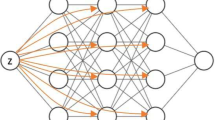Abstract
Option pricing is a process to obtain the theoretical fair value of an option based on the factors affecting its price. Currently, the nonparametric and computational methods of option valuation are able to construct a model of the pricing formula from historical data. However, these models are generally based on a global learning paradigm, which may not be able to efficiently and accurately capture the dynamics and time-varying characteristics of the option data. This paper proposes a novel brain-inspired cerebellar associative memory model for pricing American-style option on currency futures. The proposed model, called PSECMAC, constitute a local learning model that is inspired by the neurophysiological aspects of the human cerebellum. The PSECMAC-based option pricing model is subsequently applied in a mis-priced option arbitrage trading system. Simulation results show a return on investment as high as 23.1% for a relatively risk-free investment.
Preview
Unable to display preview. Download preview PDF.
Similar content being viewed by others
References
Chance, D.M.: An Introduction to Derivatives & Risk Management, 6th edn. Thomson (2004)
Nielsen, L.T.: Pricing and Hedging of Derivative Securities – Textbook in continuous-time finance theory. Oxford University Press, Oxford (1999)
Black, F., Scholes, N.: The pricing of options and corporate liabilities. Journal of Political Economy 81, 637–659 (1973)
Rendleman Jr., R.J., Bartter, B.J.: Two-state option pricing. Journal of Finance 34, 1093–1110 (1979)
Radzikowski, P.: Non-parametric methods of option pricing. In: Proc. of Informs-Korms (Seoul 2000 conference), pp. 474–480 (2000)
Amilon, H.: A neural network versus black-scholes: A comparison of pricing and hedging performances. Scandinavian Working Papers in Economics, Lund University series, Department of economics, Lund, Sweden (2001)
Anders, U., Korn, O., Schmitt, C.: Improving the pricing of options - a neural network approach. Journal of Forecasting 17(5–6), 369–388 (1998)
Qi, M., Maddala, G.S.: Option-pricing using artificial neural networks: the case of s&p500 index call options. Neural Networks in Financial Engineering, 78–92 (1995)
Hutchinson, J., Lo, A., Poggio, T.: A nonparametric approach to pricing and hedging derivative securities via learning networks. Journal of Finance 49, 851–889 (1994)
Keber, C.: Option pricing with the genetic programming approach. Journal of Computational Intelligence in Finance 7(6), 26–36 (1999)
Ait-Sahalia, Y., Lo, A.W.: Nonparametric estimation of state-price densities implicit in financial asset price. LFE-1024-95, MIT-Sloan School of Management (1995)
Tung, W.L., Quek, C.: GenSo-OPATS: A brain-inspired dynamically evolving option pricing model and arbitrage trading system. In: Proc. IEEE CEC 2005, Edinburgh, Scotland, vol. 3, pp. 2429–2436 (2005)
Huang, K., Yang, H., King, I., Lyu, M.: Local learning vs. global learning: An introduction to maxi-min margin machine. In: Wang, L. (ed.) Support Vector Machines: Theory and Applications, vol. 177, pp. 113–132. Springer, Heidelberg (2005)
Bottou, L., Vapnik, V.: Local learning algorithms. Neural Computation 4, 888–900 (1992)
Kandel, E.R., Schwartz, J.H., Jessell, T.M.: Principles of Neural Science, 4th edn. McGraw-Hill, New York (2000)
Middleton, F.A., Strick, P.L.: The cerebellum: An overview. Trends in Cognitive Sciences 27(9), 305–306 (1998)
Albus, J.S.: Marr and Albus theories of the cerebellum two early models of associative memory. In: Proc. IEEE Compcon (1989)
Albus, J.S.: A new approach to manipulator control: The Cerebellar Model Articulation Controller (CMAC). J. Dyn. Syst. Meas. Control, Trans. ASME, 220–227 (1975)
Albus, J.S.: Data storage in Cerebellar Model Articullation Controller (CMAC). J. Dyn. Syst. Meas. Control, Trans. ASME, 228–233 (1975)
Yamamoto, T., Kaneda, M.: Intelligent controller using CMACs with self-organized structure and its application for a process system. IEICE Trans. Fundamentals 82(5), 856–860 (1999)
Commuri, S., Jagannathan, S., Lewis, F.L.: CMAC neural network control of robot manipulators. J. Robot Syst. 14(6), 465–482 (1997)
Ang, K., Quek, C.: Stock trading using PSEC and RSPOP: A novel evolving rough set-based neuro-fuzzy approach. IEEE Congress on Evolutionary Computation (2005)
Federmeier, K.D., Kleim, J.A., Greenough, W.T.: Learning-induces multiple synapse formation in rat cerebellar cortex. Neuroscience Letters 332, 180–184 (2002)
Teddy, S.D., Quek, C., Lai, E.M.K.: Psecmac: A brain-inspired multi resolution cerebellar learning memory model. Neural Computation (under review, 2006)
Widrow, B., Stearns, S.D.: Adaptive Signal Processing. Prentice-Hall, Englewood Cliffs (1985)
Chicago Mercantile Exchange, U. Online, http://www.cme.com
Gencay, R.: The predictability of security returns with simple trading rules. Journal of Empirical Finance 5(4), 347–359 (1998)
Author information
Authors and Affiliations
Editor information
Editors and Affiliations
Rights and permissions
Copyright information
© 2006 Springer-Verlag Berlin Heidelberg
About this paper
Cite this paper
Teddy, S.D., Lai, E.M.K., Quek, C. (2006). A Brain-Inspired Cerebellar Associative Memory Approach to Option Pricing and Arbitrage Trading. In: King, I., Wang, J., Chan, LW., Wang, D. (eds) Neural Information Processing. ICONIP 2006. Lecture Notes in Computer Science, vol 4234. Springer, Berlin, Heidelberg. https://doi.org/10.1007/11893295_42
Download citation
DOI: https://doi.org/10.1007/11893295_42
Publisher Name: Springer, Berlin, Heidelberg
Print ISBN: 978-3-540-46484-6
Online ISBN: 978-3-540-46485-3
eBook Packages: Computer ScienceComputer Science (R0)




